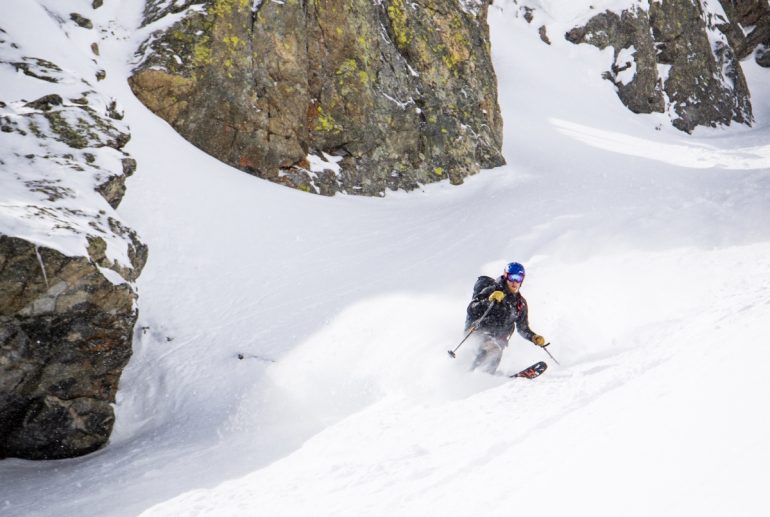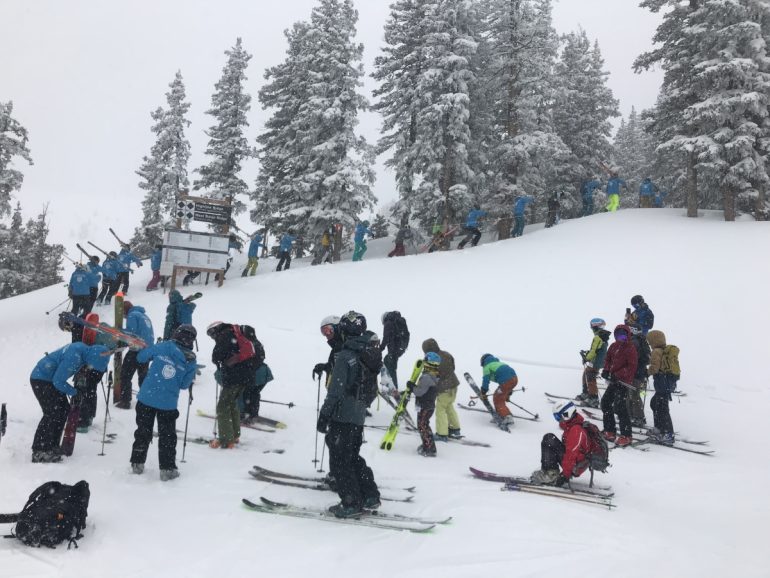Backcountry telemark skiing is on life support. Here’s how to fix it.
By Nick Cherney
For years, the mainstream ski media has been declaring the death of telemark skiing. This tends to send a certain segment of our population into a long tirade matched only by vegan crossfitters when told they are endangering their health. Of course, even such counter (ski) cultural icons as WildSnow have largely written off telemark skiing; this is in fact only one of scant telemark specific articles to grace these hallowed pages for over a decade.
So, it may seem surprising that a dedicated tele skier such as myself, prone to Facebook rants, proselytizing, and pocket GORP, would argue that telemark skiing does indeed face a pending death, at least in the backcountry. Despite abandoning alpine gear 19 years ago, strenuously arguing that alpine turns on tele gear amounts to treason, mocking alpine training heels, and spending the last nine years coaching youth telemark programs, I secretly bought a full rando race set up last season.
In fairness, this was purely to try and avoid the pain of the Grand Traverse that only a telemark skier can truly understand, but it still triggered some deep seated shame. Jake Sakson, our local telemark muse here in the Roaring Fork Valley, adamantly argued on my favorite episode of every skier’s favorite podcast, Totally Deep, that AT gear is a sign of the decline of the human physique. While this is clearly an inarguable fact, I will try to explain below why backcountry telemarking is on life support, and what we can do to fix it.
From essential to borderline obsolete: a brief history
First, let us recall that the resurgence of telemark skiing in the 70’s and 80’s triggered the backcountry skiing renaissance we are all enjoying today. While touring on cross country skis was of course a lot of fun, if you wanted to make actual turns in the backcountry under your own power, you had to learn to telemark. I wasn’t there for the 70’s or 80’s, but even in 2000, when I wanted to start skiing in the backcountry, I had to start by learning the telemark turn. I did this every week at Tele Tuesdays, a free group lesson for Vail employees. I quickly realized what everyone who learns to properly execute a telemark turn learns: it is an objectively superior art form. It is also clearly inferior from the standpoint of practicality. But we did it anyway because we wanted to go into the backcountry, so we slogged on until we were proficient and by then there was no looking back.
In the intervening decades two things have happened. One: telemark gear has massively improved and modernized for attacking aggressive lines. This means we have skiers on modern tele gear putting down lines in big mountain competitions that would be unimaginable to most telemark skiers 20 years ago, and are on par with what is happening in alpine big mountain skiing. But that gear is heavy and stiff, perfect for a resort skier, and tortuous for a 9-mile approach on a hut trip.
Second: skimo has exploded, and with it, seemingly annual leaps in gear quality, stiffness, and weight. Having done the Grand Traverse (slowly) twice in telemark gear, I decided I would not go through that suffering again. Last year when I built the spreadsheets, I just couldn’t believe how much more efficient and light a modern skimo set up was. After a season of training and completing the race (slightly less slowly) in a full set up that weighed less than my telemark boots, I even kept my toenails. But, boy, the downhills sure were boring.
So, why will anyone put in the work to learn to telemark (thereby reach a higher plane of skiing consciousness) if the practical need in the backcountry is not only gone, but is actually a disadvantage? The fact is that people bow hunt, fly fish, ride single speed mountain bikes, and all sorts of things that are impractical, and maybe harder, because, well, humans innately love both beauty and challenge.
I firmly believe that most skiers, if not put off by the sanctimonious tones we telemark skiers love to adopt, will admit that there is something beautiful and dynamic in the turn that is appealing to those who love the mountains, and that they would probably love to try. If only it was easier. And so, most innovation in the last 20 years of telemark equipment has been about making it easier. Stiffer, more active, heavier duty bindings. Taller, stiffer boots, etc. I won’t digress into my views on whether this gear is conducive to making better telemark skiers, but it certainly shortens the learning curve, and makes skiing more fun in more varied terrain for a wider range of skiers.
Why hasn’t the gear progressed further, and why isn’t it lighter? To be blunt, it’s because we have a user problem. I love telemark skiers, but holy crap, we are cheap. I regularly see people skiing in 15-year-old boots, and 20-year-old bindings. This would be unimaginable for an alpine skier. Not only are these people suffering with ancient technology, but they are hindering the ability for the industry to justify real R&D on better equipment. Companies like 22 Designs, Meidjo, and Bishop are actively experimenting with new products, and overwhelmingly that effort is put into making telemarking easier in more varied conditions, which translates into stiffer, heavier equipment. And even with the absolutely clear improvement this equipment has delivered, we still hang on to our favorite pair of Chilis, with packed out liners in an ancient pair of T2s. This does not support progress, although it does I suppose help to keep the wire and duct tape industries booming.
But, I argue, today telemark skiing as a whole is far from dead, and is in fact finding a new generation of skiers. The single largest phenomenon in youth skiing today is the explosion of big mountain skiing occurring all over the country, particularly in the west. The International Freeskiers and Snowboarders Association (IFSA), first imagined by Shane McConkey, now sponsors over 70 youth big mountain competitions across the country, most of which sell out in minutes. Many ski programs have more big mountain athletes than alpine racers.
As the IFSA has grown, it has helped to fuel big mountain telemark programs in resorts across the west. Last season, there were at least six programs in Colorado alone. In Aspen, we have grown from zero to 20 athletes in just five seasons. The national youth big mountain telemark championships in Taos last season had over 60 skiers. These kids did not come to telemarking the way we did, they came because it looks rad to stomp a tele landing off a big cliff, and getting barreled with a knee down on a big pow day is ecstasy. So, I see a very solid future for aggressive big mountain/ resort tele skiing.
But how many of these kids will be willing to hold up their friends in the backcountry, in order to enjoy a better turn? For me, with the state of today’s gear, every backcountry trip now is a calculation of the uphill to downhill ratio. Day mission to ski some fun lines? Tele gear. Six-day hut trip, with a few turns when possible? AT. Does it have to be this way?
My personal fantasy, of course, is to be able to have as much fun going uphill on telemark gear as I do on the way down. I frankly find alpine turns relatively boring in comparison, but trudging in heavy boots and gear on long missions into the backcountry while my friends whip past in speed suits is a drag.
The future of telemark skiing
There are glimmers of hope to be found in three areas. 1. The explosion of backcountry skiing both casual and competitive can spill over to telemark. 2. The resurgence of resort telemarking driven by gear improvements and big mountain competitions is showing people that you can tele and not be a 60 year old hippy (though that’s cool too). And 3. The gear is starting to catch up. We have extremely burly resort bindings courtesy of companies like 22 Designs and Bishop. Then Rottefella brought us the NTN system, which say what you will, has helped convince a lot of tele skiers to abandon their supply of wire and duct tape and actually buy some new gear.
Finally, in the last few years, Meidjo and 22 Designs have rolled out the first legitimate tech toe binding for tele gear. Sure, they don’t compare to an AT race binding in terms of weight, but they are huge improvement over the resort standard, and are probably comparable to many people’s hybrid resort/backcountry AT bindings.
Where the whole system today completely fails, though, is in the boots. God bless Scarpa and the T2/T1 monopoly, but why on earth can’t we get a light tele boot that performs? Their first generation AT boots had bellows, just no duck butt (the corollary of the tele duck bill, which enables the NTN system to work). All it would take is putting a light (stiff) cuff and a duck butt on a light bellowed AT boot, and we could bring the transcendentalism of telemark back to its rightful home in the backcountry.
Sure, we will almost certainly never see skimo races won on telemark gear (though some nordic skiers have come close). But backcountry telemarking could experience the same resurgence we see on resorts today. We just have to do our part. Go do rad things on tele gear and demonstrate to younger skiers you don’t have to be in leather boots and picking crumbs out of your beard to put on tele skis. Support equipment companies and ski shops by upgrading your gear (can we compromise? At least every decade?). Demand light boots that can still drive a hard line. And remember, Michael cares.
Nick Cherney is the local televangist of Carbondale, Colorado and a coach of the Telemark Team of the Aspen Valley Ski and Snowboard Club. He can often be spotted in the nearby hills, surrounded by hoards of children wearing bellowed ski boots. His life goals consist of living long enough to see Scarpa develop a lightweight telemark boot and skiing down Highlands Bowl backwards in leather boots and three-pin bindings, just to prove it can be done.
Beyond our regular guest bloggers who have their own profiles, some of our one-timers end up being categorized under this generic profile. Once they do a few posts, we build a category. In any case, we sure appreciate ALL the WildSnow guest bloggers!


